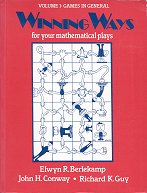
Elwyn R. Berlekamp, John Horton Conway, Richard K. Guy.
Winning Ways for Your Mathematical Plays Volume 1: games in general.
1982
(read but not reviewed)
Chapter 25 is devoted to the Game of Life.
The Book of Numbers invites you to
• fraternize with famous families of numbers
• appreciate the primacy of primes
• fathom the fractions
• imagine imaginary numbers, and
• investigate the infinite ones.
This is a book unlike any other. Ranging from a fascinating survey of number names, words and symbols to an explanation of the new phenomenon of surreal numbers (“an extremely large yet infinitely small subclass of the most recent development of number theory”), The Book of Numbers is a fun and fascinating tour of numerical topics and concepts. It will have you contemplating ideas you never thought were understandable—or even possible.
This wonderful book is crammed with fascinating facts and properties about every kind of number. Many of the properties are given a geometric interpretation, so there are plenty of marvelous diagrams. Even if you’ve come across the material before, this geometric and diagrammatic approach may give you a new perspective on things --- for example, I was particularly taken with the ’telegraph pole’ representation of infinite ordinals in the last chapter. Many more weighty presentations tend to be short on diagrams. I think this is a pity: although ’proof by diagram’ is rarely sound, and nearly always needs to be backed up by a symbolic proof, diagrams themselves can do much to help prime the intuition.
The sign of a good book: I was fascinated by what was there, and was left wanting more. Here’s a brief overview of the contents, to give you a flavour of the breadth covered.